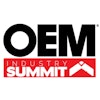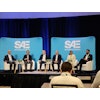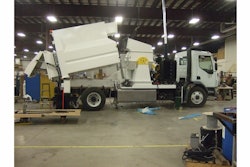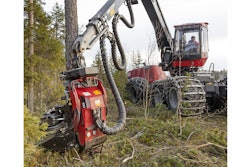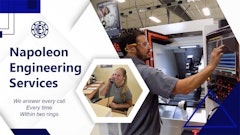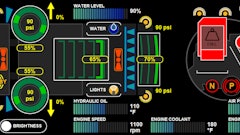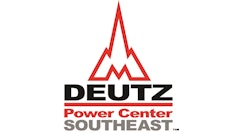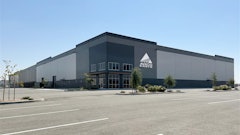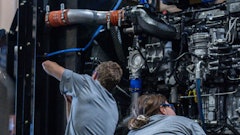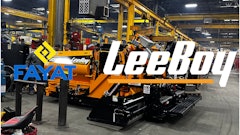For Richard Johnson, the last thing one of his drivers would do is turn on the air conditioner. “We never need it,” he laughed. “But the heater, that’s another story.”
When it comes to niche trucking, Inland Technologies might be the niche of the niches. It’s a company that makes its money when the snow falls and temperatures drop below freezing. Snow and ice on wing surfaces negatively impact safety so aircraft are de-iced using a glycol-based product generally referred to as Aircraft De-icing Fluid (ADF). “We contract to North American airports and airlines and when the de-icers come out to spray down planes, we’re the ones that vacuum up the waste aircraft de-icer after the plane pulls back from the gate,” says Johnson, who serves as Inland Technologies’ Canadian operations supervisor. “In heavy weather patterns, we’ll be running our Kenworth K370s 24/7 and unloading our 1,800-gallon tanks up to 20 times a day.”
Inland Technologies got its start in Canada where federal laws require spent ADF to be removed from airport apron areas. According to Johnson, while aircraft de-icing fluid is used for safety reasons, it breaks down very quickly in the environment, using up oxygen in lakes and streams, which can impact fish and other aquatic life. It is recovered for environmental protection reasons.
In 2010, the company began manufacturing its own custom bodies as it began seeing demand for its services increase. “We’re contracted to work at major airports, such as Toronto Pearson, Calgary International, and Dulles and Reagan airports in Washington, D.C., to collect the ADF, and then recycle the fluids for industrial market re-use,” says Johnson. “We have recycling operations set up at most of the airports where we collect ADF, while others serve as regional processing facilities. We also work with airports, which have drainage systems for the fluids. Denver, for example, has all its ADF collected through runoff drains. We then take the fluid to our plant for recycling. But, many airports don’t have the drainage system, that’s where our fleet of trucks come in.”
Inland Technologies began work with Kenworth in 2013 when it mounted six of its Glyvac™ recovery bodies on the Kenworth K370 cabover chassis. It chose a 200-inch wheelbase, which allows room for 1,800-gallon tank mounts. The K370s are powered by the PACCAR PX-7 engine rated at 260 hp, and driven through automatic transmissions.
According to Johnson, the K370 has become the standard chassis for Inland – the company plans to spec the unit when replacement or additional vehicles are needed by the company. The K370s are purchased through Bayview Kenworth in New Glasgow, Nova Scotia. Inland Technologies currently runs a total of 70 Glycol Recovery Vehicles.
The recovery system features a wash bar under the truck that directs water spray – at 725 psi – down on the tarmac; the water and ADF is then vacuumed up with a vacuum system so powerful, it could completely fill the 1,800-gallon tanker within five minutes, if it were suctioning off a pool of fluid. Each Glyvac Recovery Vehicle features a three-stage fluid separation system that removes 99 percent of glycol from the air stream. Once the tank is full, it’s off-loaded at a nearby airport collection site, where the fluids are recycled.
The Kenworth K370 is an ideal truck for Inland’s operation, according to Johnson. “We were looking for a strong truck that was durable and reliable. Our bodies are very complex pieces of equipment, so we need the truck to last as long as the mounted equipment – well beyond 10 years. What’s more, we can’t afford any downtime since these units are a mainstay for airport operations.”
A cabover was also the best choice. “We work in very tight areas – with very expensive airplanes and ground equipment in the same space – so being able to see directly in front of us, without a hood, is very important. The great visibility and excellent turning radius that the Kenworth K370 offers really enables us to do our work well,” he says.
To keep its commitment to airports, Johnson says he has the support of Kenworth dealers that are all located close to the airports served by Inland Technologies. “They are critical to our success,” Johnson says. “We can’t take our trucks to Kenworth for service. They have to come to us. And they must have parts readily available so if we need something fast, we can get serviced and back up and running. It’s been a big difference maker for us, enabling us to deliver a higher quality of service to our customers.”
Since Inland’s Glycol Recovery Vehicles are specialized for winter work – on standby for four to six months of the year, depending upon the airport – its core of drivers typically come from the construction industry. “It works well,” says Johnson. “The drivers often run construction equipment in the spring, summer and fall, and then come work for us in the winter. They’ve told us they really like driving the Kenworths. In some cases, they’ll be pulling up to 12-hour shifts in very challenging weather. So they appreciate the comfortable seat and the driving environment the K370 offers.”
Learn more about Inland's Glyvac glycol recovery vehicle in the OEM Off-Highway article, Suck it up, featured in the September 2014 issue.

